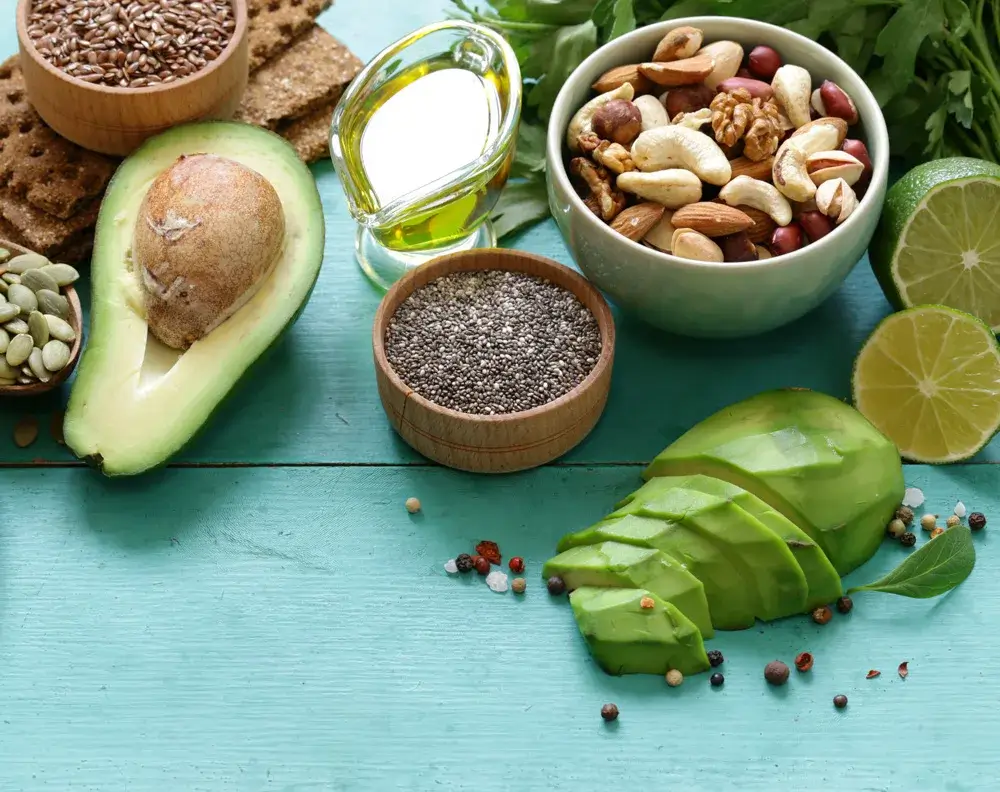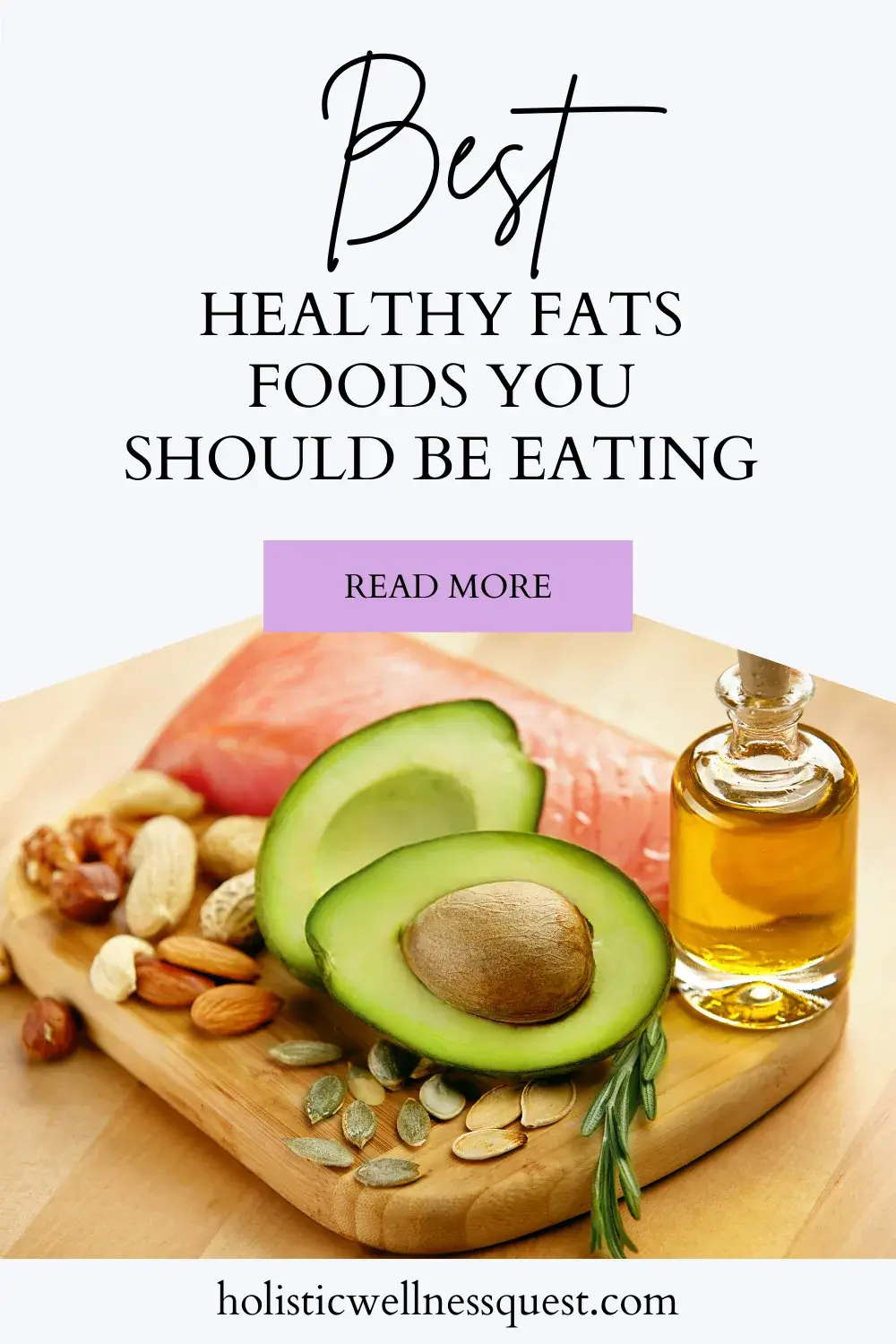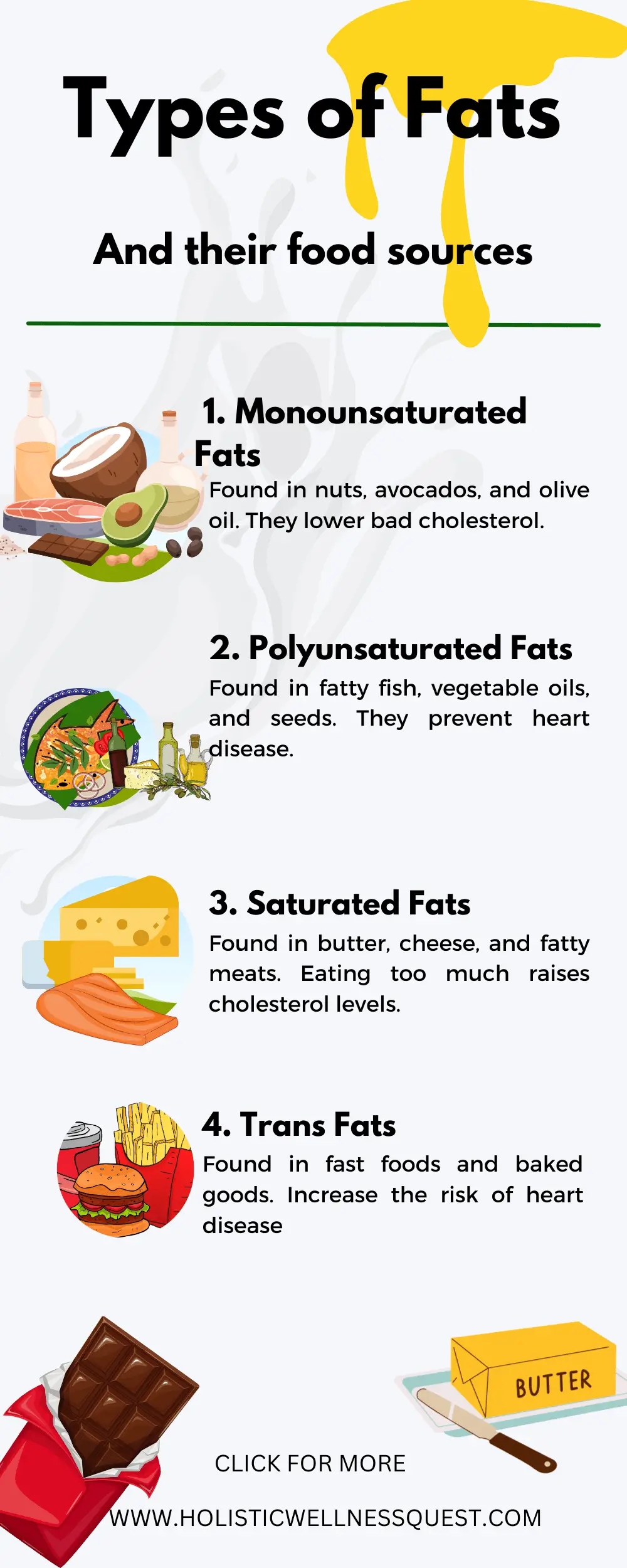The Best Healthy Fats Foods for Your Diet: Good Fats vs. Bad Fats Explained

For a long time, we thought fat in our diet was bad. In fact, we believed eating less fat was the secret to good health.
We all believed that eating fat makes us gain excess fat.
Bad press.
Surprisingly, recent studies show that some healthy fats foods are actually good for us. Healthy fats play a key role in keeping our diet balanced and our body healthy.
Healthy fats foods are now seen as essential for health. Indeed, removing fat from food often means adding carbohydrates in the form of sugar, refined grains, or starches. This can mess with our blood sugar and insulin, leading to possible weight gain in addition to other health problems.
Strangely, eating a lot or a little fat doesn’t seem to majorly impact our health. Basically, it’s more about choosing the right kinds of fats over the bad ones.

Key Takeaways
- Healthy fats foods are essential for maintaining a balanced diet and supporting overall well-being.
- Low-fat diets can sometimes lead to eating more refined carbohydrates, which may not be the best for health.
- Eating fat in moderation doesn’t necessarily cause weight gain. It’s all about balance in our diet.
- Focusing on beneficial monounsaturated and polyunsaturated fats, while reducing harmful trans fats and watching our intake of saturated fats, is crucial for health.
- Choosing healthy high fat foods can be good for the heart, help with weight management, and boost overall health.
Understanding Fats: The Basics
Fats are essential for energy and vital body functions. There are different kinds like, in particular, saturated and unsaturated fats. Knowing about these fats helps keep your heart and body healthy.
What Are Fats?
Fats are a type of nutrient called a macronutrient. Typically, our bodies need macronutrients in large amounts. They include fats, proteins, and carbohydrates.
Fats are important for many functions in our body, including:
- Specifically, they provide energy and support cell growth.
- Fats also help protect our organs.
- Fats keep our bodies warm.
- Additionally, they help our bodies absorb some vitamins and produce important hormones.
Types of Fats
The main fats you eat include:
Saturated Fats
Saturated fats are found in foods such as butter, cheese, and fatty meats. These fats are solid at room temperature.
Eating too much saturated fat may raise your cholesterol levels. As a result, this can increase your risk of heart disease.
Remember to limit saturated fat intake.
Trans Fats
Trans fats are very unhealthy. They are created by adding hydrogen to vegetable oils. Consequently, this process makes the oils solid at room temperature. Trans fats are found in many fast foods and baked goods.
They raise bad cholesterol (LDL) levels and lower good cholesterol (HDL) levels. Eating trans fats can increase the risk of heart disease and other health problems.
It’s best to avoid trans fats completely.
Monounsaturated Fats
Found in nuts, avocados, and olive oil. They help your heart by lowering bad cholesterol.
Polyunsaturated Fats
These fats are found in foods such as fatty fish, vegetable oils, and seeds. They include omega-3 fatty acids and omega-6 fatty acids.
Omega-3 fatty acids are especially good for heart health. They help prevent heart disease and reduce inflammation.

Roles of Fats in the Body
- Energy Source Fats provide a lot of energy. One gram of fat has 9 calories, more than twice the calories in one gram of carbohydrates or protein. Your body uses this energy for many activities, like walking, running, and even sleeping.
- Cell Function Fats are an important part of every cell in your body. They help build cell membranes, which protect the cell and help it function properly.
- Nutrient Absorption Fats help your body absorb important vitamins. These include vitamins A, D, E, and K. Without fats, your body cannot use these vitamins effectively.
Good Fats vs. Bad Fats
Not all fats are alike.
Some fats are good for you, helping your health, while others can harm you.
The ones that help are called “good” fats. But some are “bad” because they can increase the risk of heart diseases.
Good Fats
Unsaturated fats, such as monounsaturated and polyunsaturated fats, are the best. They can lower cholesterol and heart disease risks. Besides, they might help in keeping you at a healthy weight. You can find these healthy fats in oils such as olive, canola, and foods such as avocado.
Nuts, seeds, and certain fish, like salmon and sardines, are also great sources of good fats.
Bad Fats
Saturated Fats: When They Are Harmful and When They Are Not.
Saturated fats can be harmful if you eat too much. They can raise your cholesterol levels and increase your risk of heart disease.
However, not all saturated fats are bad. In fact, some studies show that saturated fats from dairy products like cheese and yogurt may not have the same harmful effects.
Remember to consume saturated fats in moderation and choose sources that are part of a healthy diet. Indeed, the American Heart Association advises to eat very little saturated fat. They say it should be 5-6% of your daily calories at most.
Trans Fats: Why They Are Harmful and How to Avoid Them.
Trans fats are the worst type of fat. They raise bad cholesterol levels and lower good cholesterol levels. Consequently, this increases the risk of heart disease and other health problems.
Trans fats are found in many processed foods such as cookies, cakes, and fast foods. Look for “partially hydrogenated oils” on ingredient labels and avoid these foods. The American Heart Association recommends keeping trans fat intake as low as possible or better yet avoid them completely.
Top Healthy High Fats Foods
Focusing on adding healthy high fats foods is key to eating well. Indeed, good fats, like monounsaturated and polyunsaturated, are important for our hearts and health.
Here’s a look at the best high-fat foods for you.
1. Avocados
Nutritional Profile Avocados are a unique fruit.
- They are high in healthy fats. One medium avocado has about 21 grams of fat. Most of this fat is monounsaturated fat, which is good for you.
- Avocados are also rich in fiber, vitamins, and minerals.
- They contain vitamins C, E, K, and B-6, as well as folate, magnesium, and potassium.
Check out our blog on nutrient-rich foods and learn more about the healthy fats in avocados.

Avocados have many health benefits.
They can help lower cholesterol levels. This is because they are high in monounsaturated fats. These fats can reduce bad cholesterol and increase good cholesterol (HDL).
Avocados also have antioxidants, which are good for your heart health. Eating avocados can help prevent heart disease and improve overall cardiovascular health.
Easy Ways to Include Them in Your Diet
There are many easy ways to eat avocados.
- You can add them to salads for extra creaminess. They are also great in smoothies for a thick, rich texture.
- Avocados are perfect for spreading on toast.
- You can also use them as a healthy substitute for butter or mayonnaise.
- Try making guacamole for a delicious dip.
2. Nuts and Seeds
Types
There are many types of nuts and seeds. Some popular ones include:
- Almonds
- Walnuts
- Chia seeds
- Flaxseeds
These foods are high in healthy fats and other nutrients.
Nutritional Benefits
- Nuts and seeds are packed with nutrients.
- They are high in monounsaturated and polyunsaturated fats. These fats are good for heart health.
- Nuts and seeds are also rich in protein, fiber, vitamins, and minerals.
- They have vitamin E, magnesium, and selenium. Basically, eating nuts and seeds can help lower cholesterol and reduce the risk of heart disease.
Serving Suggestions
- You can enjoy nuts and seeds in many ways. For instance, eat a handful as a quick snack.
- Add them to yogurt or oatmeal for extra crunch.
- Sprinkle them on salads or vegetables.
- You can also use them in baking or cooking.
- Make a nut or seed butter for a tasty spread.

3. Fatty Fish
Fatty fish are high in healthy fats. Some examples are salmon, mackerel, and sardines. These fish are rich in omega-3 fatty acids.
Omega-3 Fatty Acids Benefits Omega-3 fatty acids are very beneficial for your health.
- They can reduce inflammation and lower the risk of heart disease.
- Omega-3s can also improve brain health and function.
- Eating fatty fish can help prevent cardiovascular disease.
Cooking Tips
- You can bake, grill, or broil them. Add some herbs and lemon for extra flavor.
- You can also poach or steam them for a lighter option. Try to include fatty fish in your meals at least twice a week.

4. Olive Oil
Nutritional Properties
Olive oil is another healthy fat.
- It is high in monounsaturated fats. These fats are good for your heart.
- Olive oil also has antioxidants and anti-inflammatory properties.
Health Benefits
Olive oil has many health benefits:
- Specifically, it can help lower cholesterol levels. This reduces the risk of heart disease.
- Olive oil can also improve blood sugar levels and aid in weight management.
- Basically, using olive oil regularly can promote heart health and reduce the risk of chronic diseases.
Cooking and Usage Tips
Olive oil is very versatile.
- Use it for cooking, sautéing, or frying.
- Drizzle it over salads or vegetables.
- You can also use it as a dip for bread.
Choose extra virgin olive oil for the best health benefits.
Remember to store it in a cool, dark place to keep it fresh.

5. Coconut Oil
Medium-Chain Triglycerides (MCTs) and Benefits
Coconut oil is high in a type of fat called medium-chain triglycerides (MCTs). MCTs are easier for your body to digest and use for energy. They can help boost metabolism and support weight loss. Coconut oil can also increase good cholesterol (HDL) and improve overall heart health.
Best Uses in Cooking and Baking
Coconut oil is very versatile. It is solid at room temperature but melts quickly when heated.
- You can use it for frying, baking, and sautéing. It adds a light, sweet flavor to foods.
- Use coconut oil in baking recipes as a substitute for butter or vegetable oils.
- It’s also great for making homemade granola or energy bars.

6. Dark Chocolate
Nutritional Value
Dark chocolate is a delicious treat that is also good for you. It is high in healthy fats, antioxidants, and minerals. A standard serving (about 1 ounce) has around 7 grams of fat. Most of this fat is saturated fat, but it also contains some monounsaturated fat.
Dark chocolate is also rich in iron, magnesium, copper, and manganese.
Health Benefits
Eating dark chocolate can have many health benefits:
- Indeed, it can improve heart health by lowering blood pressure and reducing cholesterol levels.
- The antioxidants in dark chocolate can help prevent heart disease.
- It can also improve brain function and mood.
How to Choose the Healthiest Options
When choosing dark chocolate, look for options with at least 70% cocoa. Basically, the higher the cocoa content, the more antioxidants and less sugar it contains.
Avoid dark chocolate with added fats like partially hydrogenated oils.
Always check the label to make sure it is free from trans fats.

7. Full-Fat Dairy
Types (e.g., Yogurt, Cheese)
Full-fat dairy products include foods like yogurt, cheese, and milk.
These foods are high in healthy fats and provide many essential nutrients. Full-fat yogurt and cheese are especially popular and easy to find. Check out our blog on delicious low-carb dinner ideas and learn more about how full-fat dairy is keto-friendly.
Benefits of Full-Fat Over Low-Fat
Full-fat dairy has several benefits over low-fat options.
- It is more satisfying and can help you feel full longer. This can aid in weight management.
- Full-fat dairy also has more vitamins and minerals because these nutrients are often lost in the process of making low-fat products.
- Moreover, recent studies have shown that full-fat dairy does not increase the risk of heart disease and may even help reduce it.
Best Choices and Serving Ideas
- Choose full-fat dairy products that are minimally processed. Greek yogurt, aged cheeses, and whole milk are great options.
- Enjoy yogurt with fresh fruit or use it in smoothies.
- Add cheese to salads, sandwiches, or enjoy it on its own as a snack.

8. Eggs
Nutritional Benefits
- Eggs are a great source of healthy fats and high-quality protein. One large egg has about 5 grams of fat, most of which is unsaturated fat.
- Eggs are also rich in vitamins and minerals like vitamin D, B vitamins, and selenium.
- Additionally, they contain choline, which is important for brain health.
Importance of Whole Eggs
Eat whole eggs, including the yolk.
You could be wondering, but why the yolk?
Surprisingly, the yolk contains most of the nutrients and healthy fats. While the yolk does have cholesterol, dietary cholesterol does not significantly impact blood cholesterol levels for most people. Eating whole eggs can improve heart health and provide many essential nutrients.
Recipe Ideas
There are many ways to include eggs in your diet.
- Make a simple scrambled egg for breakfast.
- Add boiled eggs to salads for extra protein.
- Try making an omelet with vegetables and cheese.
- Eggs are also great for baking and can be used in a variety of recipes.

9. Cheese
Nutritional Profile
Cheese is a high fat food that is also rich in protein and calcium. A typical serving of cheese (1 ounce) has about 9 grams of fat. This includes both saturated fat and monounsaturated fat.
Cheese also provides essential vitamins and minerals like vitamin A, vitamin B12, zinc, and phosphorus.
Varieties and Health Benefits
There are many types of cheese, each with unique flavors and health benefits. Some popular varieties include cheddar, mozzarella, and goat cheese.
- Cheese can help improve bone health due to its high calcium content.
- It also contains conjugated linoleic acid (CLA), a fatty acid that may help reduce body fat and improve heart health. Despite its saturated fat content, moderate cheese consumption does not significantly raise cholesterol levels and can be part of a healthy diet.
Best Ways to Enjoy
Cheese is versatile and can be enjoyed in many ways.
- Add it to sandwiches, salads, and pasta dishes.
- Pair cheese with fruits and nuts for a nutritious snack.
- You can also melt it over vegetables or use it in casseroles and baked dishes.
Remember to enjoy cheese in moderation due to its high calorie and fat content.
10. Grass-Fed Butter
Nutritional Benefits Compared to Regular Butter
- Grass-fed butter is made from the milk of grass-fed cows. It has a higher nutritional value than regular butter.
- Grass-fed butter contains more omega-3 fatty acids, which are good for heart health. It also has higher levels of vitamin K2, which helps improve bone health and reduce the risk of heart disease.
- Grass-fed butter is rich in conjugated linoleic acid (CLA), which may help reduce body fat.
Uses in Cooking and Baking
Grass-fed butter is solid at room temperature and can be used just like regular butter. It is great for cooking and baking.
- Use it to sauté vegetables or fry eggs.
- Spread it on toast or melt it over steamed vegetables.
- Grass-fed butter adds rich flavor to baked goods like cookies, cakes, and pastries.
- It is also a good substitute for oils in many recipes.

How to Incorporate Healthy Fats Foods into Your Diet
Meal Planning
Balance your fat intake with other macronutrients like protein and carbohydrates. Include a variety of healthy fats foods in your meals. Combine healthy fats with proteins and carbs to make balanced meals.
For example, you can add avocado to a chicken salad or olive oil to a vegetable stir-fry. This way, you get the benefits of all nutrients.
Portion Control
Fats are high in calories. Therefore, it’s important to control your portions. Eating too much fat, even healthy fats, can lead to weight gain. Use small amounts of oils and spreads.
Remember to measure out nuts and seeds instead of eating straight from the bag. A small handful of nuts or a tablespoon of olive oil is usually enough.
Snack Ideas
Healthy High Fats Snacks On the Go
Healthy snacks can keep you full between meals. Choose snacks that are high in good fats. Here are some ideas:
- A handful of almonds or walnuts.
- Slices of avocado on whole-grain toast.
- Greek yogurt with a drizzle of olive oil and some seeds.
- Dark chocolate (70% cocoa or higher).
- A small piece of cheese with apple slices. These snacks are easy to prepare and take with you.

Cooking Tips
Best Cooking Methods to Preserve Fat Quality
The way you cook can affect the quality of fats. Use gentle cooking methods to preserve healthy fats in your food.
Avoid deep frying, which can create harmful trans fats.
Instead, try baking, steaming, or sautéing with olive oil. These methods keep the fats healthy and add flavor to your food.
Healthy Fat Substitutions in Recipes
Additionally, you can make recipes healthier by replacing bad fats with good fats.
- You can use olive oil or coconut oil instead of butter or margarine.
- Substitute Greek yogurt for sour cream.
- Replace cream cheese with avocado spread.
These swaps can improve the fat content of your meals and support heart health.
Common Myths About Dietary Fats
Myth 1: All Fats Are Bad
We all agree that not all fats are bad.
There are different types of fats. In fact, monounsaturated fats and polyunsaturated fats are good for you. They can improve cholesterol levels and reduce the risk of heart disease.
Healthy fats are found in foods like olive oil, avocados, and fatty fish.
Myth 2: Low-Fat Diets Are the Healthiest
Low-fat diets are not always the healthiest.
Yes. Your body needs fats for energy, cell function, and nutrient absorption. Indeed, healthy fats are part of a balanced diet. They can help prevent heart disease and improve overall health. The American Heart Association recommends including healthy fats in your diet.
Myth 3: Eating Fat Makes You Fat
Eating fat does not necessarily make you fat.
Weight gain occurs when you consume more calories than you burn. Healthy fats can actually help you feel full and satisfied, which can prevent overeating. In fact, this is the basis of a keto diet for weight loss.
Remember, it’s important to manage portion sizes and balance fat intake with other nutrients.
Debunking These Myths with Scientific Evidence
Scientific studies have shown the benefits of healthy fats foods.
For example, randomized controlled trials have found that diets high in monounsaturated fats can improve cholesterol levels and reduce heart disease risk. Research also shows that replacing saturated fats with unsaturated fats can improve heart health. The Dietary Guidelines for Americans recommend including healthy fats as part of a balanced diet.

Conclusion
In conclusion, understanding the difference between good fats and bad fats is key to better health.
Instead of cutting out fats completely, focus on the right ones. Include more monounsaturated and polyunsaturated fats from foods such as nuts, seeds, olive oil, and fatty fish.
This is while you avoid trans fats and eat saturated fats in moderation. By making these simple changes, you will help your heart health, control your weight, and boost your overall wellness.
Remember, a balanced diet includes dietary fats from wholesome, whole-food sources.
It’s time to say goodbye to the idea of low-fat diets. Start exploring the benefits of good fats. They can make your body strong, increase your energy, and lower your disease risk.
With a bit of know-how and creativity, add these healthy high-fat foods to your daily eating plan. This way, you move toward a vibrant, healthy life.
Keep in mind, it’s crucial to invest in your health. Make good fats the core of your overall wellness.
Healthy fat could actually be your new friend.
So, go on and enjoy the great tastes, experience the amazing advantages, and cherish the path to a happier, healthier you.
FAQ
What are the different types of fats?
There are several fats, such as saturated, non- saturated and trans fats. Monounsaturated and polyunsaturated fats are considered the better option.
What are the roles of fats in the body?
Fats do important jobs in our body. Specifically, they provide energy. They also help absorb vitamins. They also vital for cell development and function.
What are the health benefits of “good” unsaturated fats?
“Good” unsaturated fats lower risks of diseases, particularly heart diseases.
What are some examples of foods high in “good” monounsaturated and polyunsaturated fats?
Foods rich in these good fats are many. They include various oils, such as olive and coconut oil, nuts, seeds, avocado, and fatty fish.
How can I incorporate more healthy fats into my diet?
To add healthy fats, focus on certain foods. Use olive oil, snack on nuts, sprinkle seeds on your salads, and and eat fish. Avocado toast, nut mixes, and Greek yogurt are good snacks. Use oils like olive in cooking. Avoid too much frying.
Is a low-fat diet the healthiest approach?
Not all fats are bad. Some fats, like monounsaturated and polyunsaturated are not only beneficial but necessary for the body. Besides, low-fat diets might make us eat too many refined carbs, which can hurt blood sugar and insulin levels.